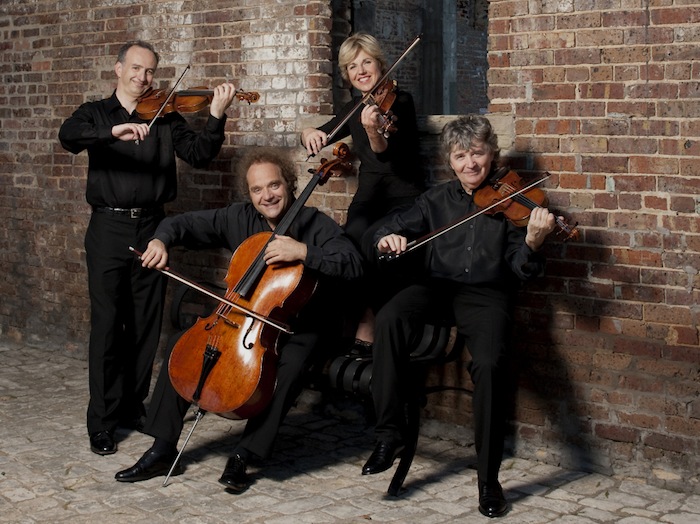Takács Quartet wraps Bartok series with compelling mastery

The Takacs Quartet concluded their Bartok cycle for the Celebrity Series Friday night at Jordan Hall.
Many ensembles can play Bartok’s string quartets with rhythmic intensity and a personal style. But there may be no other group on the scene today that performs these works with as much panache and expressive sweep as the Takács Quartet.
In their Celebrity Series recital last month, the ensemble brought interpretations to three of the composer’s six quartets that were memorable for their lyricism and enveloping warmth, characteristics not usually associated with these works. The musicians’ readings of the Second, Fourth, and Sixth Quartets, heard in their return to Jordan Hall Friday night, were similarly vigorous, euphonious, and, moreover, compelling.
The Takács Quartet has carved out a reputation for wide-ranging programs and recordings—the last three years alone brought releases of Schubert, Haydn, and Britten string quartets—but with the Bartók set the musicians return to the roots of their success.
The quartets are the keystone of Bartók’s chamber music. They show a composer experimenting with new techniques while tipping his hat to works of the past. Beethoven’s late quartets were especially influential. But Bartók was a vigorous collector of folk music, and the side-winding lines of these pieces bear the imprint of East European songs and dances.
The Second Quartet—equal parts lyrical, dynamic, and reflective—shows the composer on the very edge of romanticism, yet he was pushing the boundaries of tonality beyond where he had taken it in his first essay in the genre. Splintering dissonances and episodes of bitonality, which he had explored in his earlier Bagatelles for piano, recall the efforts of Stravinsky and Milhaud.
The piece opened with interlocking lines and seemingly wandering chromaticism, all which the Takács gave a stirring and burnished reading. The finale was haunting. Its searching melodies and serene harmonies unfolded into yearning statements that were passed effortlessly between each player. For the furious second movement, the musicians dug in for a course, biting tone, which gave the churning phrases palpable intensity.
The Fourth Quartet carries these elements to the extreme. The work makes handy use of brash statements, glassy slides, and prickly sonorities in its five-part arch form.
But such passages of intensity never got in the way of the music’s lush moments. Cellist András Fejér gave his Magyar-style melody in the third movement a beautiful singing tone. This music also abounds with colorful effects. The high notes on Geraldine Walther’s viola wailed like a ghost before unfolding into full-bodied statements in her instrument’s lower register.
The musicians attacked the motives that pepper the first movement with vigor. The energetic and well-timed string snaps—called Bartók pizzicatos—brought a touch of humor to the fourth movement. The quartet played the bone-rattling finale with aplomb, the robust chords sounding their fullest without the sharp-edged tone often heard in performances of this work.
The music of the Sixth String Quartet seems to come from two different worlds. On one hand, the mournful lines of the recurring Mesto theme recall the lyric sensitivity the composer mined in his early works. Yet the music still contains the driving rhythms and ear-stretching sonorities so common to the composer’s experimental style.
The Takács musicians found both the romance and humor in the Vivace. They played the March with a sure-footed swagger. The Burletta had the rustic vigor of a village band. And with the melancholy strains of the final movement, the quartet and concert as whole came full circle. It is mesmerizing music, and the Takács delivered a mesmerizing performance.
The next Celebrity Series event will bring together Marc-André Hamelin and Emanuel Ax in a duo recital featuring works by Brahms 3 p.m. Sunday at Symphony Hall. celebrityseries.org; 617-482-2595.
Posted in Performances



